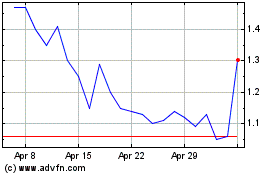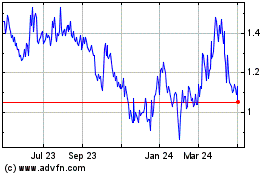Major Improvements Made to OPC1 Production,
Including to Process, Purity, Potency, and Scale
Lineage Cell Therapeutics, Inc. (NYSE American and TASE: LCTX),
a clinical-stage biotechnology company developing allogeneic cell
therapies for unmet medical needs, today provided an update on
OPC1, its oligodendrocyte progenitor cell (OPC) allogeneic
transplant for the treatment of acute spinal cord injuries (SCI).
The Company reported it has developed an enhanced differentiation
process, leading to major improvements in production and quality of
its OPC1 cell therapy drug product, including:
- A new ready-to-inject formulation of OPC1, which enables
clinical use at a much larger number of spinal cord treatment
centers, accelerating enrollment for a larger and potentially
registrational clinical trial.
- Elimination of dose preparation, reducing overall preparation
time from 24 hours to 30 minutes and cutting logistics costs by
approximately 90%.
- A 10 to 20-fold increase in OPC1 production scale, sufficient
to support late-stage clinical development and which can be further
scaled to meet initial commercial use.
- A 50-75% reduction in product impurities.
- Improvements in OPC1 functional activity, as assessed by
cellular migration and secretion of key growth factors.
- Development of 12 new analytical and functional methods for
in-process quality control and release of improved product.
- Elimination of all animal-based production reagents resulting
in a xeno-free final product formulation, consistent with
guidelines preferred by U.S. and European regulatory agencies.
- Filing of patent applications on the process and product which,
if allowed, are anticipated to have expiration dates in 2039 and
2040.
“Manufacturing is the foundation of cell therapy and the
significant enhancements we have achieved with OPC1 marks the
second time we have successfully transformed a research-grade
production process into one capable of supporting a successful
commercial product. The first instance was with OpRegen, our dry
AMD program, from which we now can generate 5 billion 99% pure RPE
cells in a single 3-liter bioreactor. We’ve achieved similar
value-creating improvements with the production of oligodendrocytes
for our spinal cord program and I expect we also will be successful
with our next endeavor, modernizing the production of allogeneic
dendritic cells to support our immuno-oncology platform,” stated
Brian M. Culley, Lineage CEO. “Our objective is to be the premier
allogeneic cell therapy company and our dedication to manufacturing
excellence allows us not only to reduce or eliminate certain
regulatory and commercial hurdles, but also establish strong
competitive barriers in our field. Looking ahead, we are reviewing
our options to return OPC1 to clinical testing in a late-stage,
comparative clinical trial and evaluating bespoke delivery
solutions for our OPC1 cells.”
A further discussion of the manufacturing improvements made to
the OPC1 program will be available today at 12:00 pm Eastern Time /
9:00 am Pacific Time on an analyst-led webinar hosted by FORCE
Wealth. Mr. Culley and Brandi Roberts, Lineage’s CFO, will
participate in a fireside chat hosted by Joseph Pantginis, Ph.D.,
Managing Director, Equity Research at H.C. Wainwright & Co.,
LLC. Interested investors can access the live presentation on the
Events and Presentations section of Lineage’s website and an
archived presentation will be available for 30 days. Additional
videos are available on the Media page of the Lineage website,
located at www.lineagecell.com/media/.
About Spinal Cord Injuries
A spinal cord injury (SCI) occurs when the spinal cord is
subjected to a severe crush or contusion and frequently results in
severe functional impairment, including limb paralysis, aberrant
pain signaling, and loss of bladder control and other body
functions. There are approximately 18,000 new spinal cord injuries
annually in the U.S. There are no FDA-approved drugs specifically
for the treatment of SCI. The cost of a lifetime of care for a
severe spinal cord injury can be as high as $5 million.
About OPC1
OPC1 is an oligodendrocyte progenitor cell (OPC) transplant
therapy designed to provide clinically meaningful improvements in
motor recovery in individuals with acute spinal cord injuries
(SCI). OPCs are naturally occurring precursors to the cells which
provide electrical insulation for nerve axons in the form of a
myelin sheath. The OPC1 program has been partially funded by a
$14.3 million grant from the California Institute for Regenerative
Medicine. OPC1 has received Regenerative Medicine Advanced Therapy
(RMAT) designation and Orphan Drug designation from the U.S. Food
and Drug Administration (FDA).
About the OPC1 Clinical Study
The SCiStar Study of OPC1 is an open-label, 25-patient,
single-arm trial testing three sequential escalating doses of OPC1
administered 21 to 42 days post-injury in patients with subacute
motor complete (AIS-A or AIS-B) cervical (C-4 to C-7) acute spinal
cord injuries (SCI). Patient enrollment in this study is complete;
96% of patients reported one level of improved motor function and
33% of patients reported two levels of improved motor function.
Patients continue to be evaluated on a long-term basis. Patients
enrolled in the SCiStar study had experienced severe paralysis of
the upper and lower limbs. The primary endpoint in the SCiStar
study was safety as assessed by the frequency and severity of
adverse events related to OPC1, the injection procedure, and
immunosuppression with short-term, low-dose tacrolimus. Secondary
outcome measures included neurological functions measured by upper
extremity motor scores (UEMS) and motor level on International
Standards for Neurological Classification of Spinal Cord Injury
(ISNCSCI) examinations through 365 days post-treatment.
About Lineage Cell Therapeutics, Inc.
Lineage Cell Therapeutics is a clinical-stage biotechnology
company developing novel cell therapies for unmet medical needs.
Lineage’s programs are based on its robust proprietary cell-based
therapy platform and associated in-house development and
manufacturing capabilities. With this platform Lineage develops and
manufactures specialized, terminally differentiated human cells
from its pluripotent and progenitor cell starting materials. These
differentiated cells are developed to either replace or support
cells that are dysfunctional or absent due to degenerative disease
or traumatic injury or administered as a means of helping the body
mount an effective immune response to cancer. Lineage’s clinical
programs are in markets with billion dollar opportunities and
include three allogeneic (“off-the-shelf”) product candidates: (i)
OpRegen®, a retinal pigment epithelium transplant therapy in Phase
1/2a development for the treatment of dry age-related macular
degeneration, a leading cause of blindness in the developed world;
(ii) OPC1, an oligodendrocyte progenitor cell therapy in Phase 1/2a
development for the treatment of acute spinal cord injuries; and
(iii) VAC, an allogeneic dendritic cell therapy platform for
immuno-oncology and infectious disease, currently in clinical
development for the treatment of non-small cell lung cancer. For
more information, please visit www.lineagecell.com or follow the
Company on Twitter @LineageCell.
Forward-Looking Statements
Lineage cautions you that all statements, other than statements
of historical facts, contained in this press release, are
forward-looking statements. Forward-looking statements, in some
cases, can be identified by terms such as “believe,” “may,” “will,”
“estimate,” “continue,” “anticipate,” “design,” “intend,” “expect,”
“could,” “plan,” “potential,” “predict,” “seek,” “should,” “would,”
“contemplate,” project,” “target,” “tend to,” or the negative
version of these words and similar expressions. Such statements
include, but are not limited to, statements relating to Lineage’s
manufacturing improvements and anticipated patent expiration dates.
Forward-looking statements involve known and unknown risks,
uncertainties and other factors that may cause Lineage’s actual
results, performance or achievements to be materially different
from future results, performance or achievements expressed or
implied by the forward-looking statements in this press release,
including risks and uncertainties inherent in Lineage’s business
and other risks in Lineage’s filings with the Securities and
Exchange Commission (the SEC). Lineage’s forward-looking statements
are based upon its current expectations and involve assumptions
that may never materialize or may prove to be incorrect. All
forward-looking statements are expressly qualified in their
entirety by these cautionary statements. Further information
regarding these and other risks is included under the heading “Risk
Factors” in Lineage’s periodic reports with the SEC, including
Lineage’s Annual Report on Form 10-K filed with the SEC on March
12, 2020 and its other reports, which are available from the SEC’s
website. You are cautioned not to place undue reliance on
forward-looking statements, which speak only as of the date on
which they were made. Lineage undertakes no obligation to update
such statements to reflect events that occur or circumstances that
exist after the date on which they were made, except as required by
law.
View source
version on businesswire.com: https://www.businesswire.com/news/home/20201208005265/en/
Lineage Cell Therapeutics, Inc. IR Ioana C. Hone
(ir@lineagecell.com) (442) 287-8963
Solebury Trout IR Gitanjali Jain Ogawa
(Gogawa@troutgroup.com) (646) 378-2949
Russo Partners – Media Relations Nic Johnson or David
Schull Nic.johnson@russopartnersllc.com
David.schull@russopartnersllc.com (212) 845-4242
Lineage Cell Therapeutics (AMEX:LCTX)
Historical Stock Chart
From Mar 2024 to Apr 2024

Lineage Cell Therapeutics (AMEX:LCTX)
Historical Stock Chart
From Apr 2023 to Apr 2024
